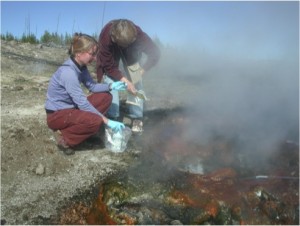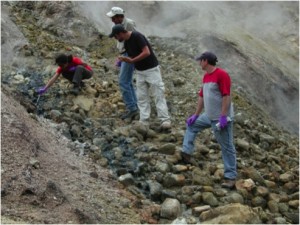[Note: This article originally appeared in the Autumn 2013 issue of the JGI Primer.]
Life on Earth finds a way to survive almost anywhere there is a source of energy to support it. In Yellowstone National Park (YNP), this phenomenon is in the extreme by microorganisms that thrive in harsh, acidic hot springs found unsuitable for the rest of Earth’s inhabitants.

Niki Parenteau (left) and Beverly Pierson (right) sample red-layer phototrophic mats at
Fairy Geyser, August 2007 (Image courtesy of Bill Inskeep)
A team of researchers including DOE JGI scientists set out to investigate how these habitats support microbial life, and to correlate the microbial inhabitants with geochemical variables across different springs in YNP. From the Department of Energy’s perspective, the microbes at Yellowstone are of interest to biofuels researchers because they are thermophilic, meaning they thrive in high-temperature environments. Some of these thermophilic bacteria have been found to contain enzymes that break down biomass into sugars that can be deployed in the industrial-scale production of biofuels.
“The idea was to get a comprehensive overview of microbial communities in Yellowstone National Park,” said DOE JGI Metagenome Program head Susannah Tringe, an author on a series of papers on Yellowstone microbial communities that appeared in Frontiers in Microbial Physiology and Metabolism between May 15, 2013 and June 3, 2013. “Many springs have been studied by independent lab groups, but there had been no coordinated attempt to compare them.”
William Inskeep, a professor at Montana State University and long-time DOE JGI collaborator who has dedicated a great portion of his life’s research to studying YNP, initiated the project to get in-depth looks at the three separate types of communities collected from 20 separate sites within the park. Through the DOE JGI’s Community Sequencing Program (CSP), Inskeep and his collaborators were able to complete a large-scale project in which he and a team of scientists provided samples of phototrophic (light energy dependent), chemotrophic (chemical energy dependent), and streamer-like (biofilm-forming) community DNA for metagenome sequencing.
The working theory was that certain ecological and geochemical factors contribute to the niche specialization of microbes in YNP. The fruits of the team’s labors are now becoming available to the public, allowing insights into microbial community structure and function in geothermal habitats of YNP.
“These high-temperature systems provide model environments in terms of dissecting community structure,” Inskeep said. For this reason, each of the three community types was the focus of a separate paper, with their own respective findings, in addition to an overview paper summarizing the complete project.
One of the studies focused on different types of phototrophic microbial mats that either produce oxygen (oxygenic) or not (anoxygenic). Through shotgun sequencing of several mat types, researchers were not only able to classify many of the organisms present, but also link them to processes like fermentation, carbon fixation, and photosynthesis. These processes help determine why life is sustainable in these microbial mats. The interactions that occur among members of the community are also critical to the function and survival of these organisms. The second type of community studied was the streamer-like microbial mats found in fast- flowing channels within YNP. These communities varied in metabolic and geological traits, with research pointing out that streamer communities are found across a broad pH range and under high and low levels of oxygen. However, because of the way these communities are distributed, the genes associated with energy production show that these microbes have adapted to special niches within YNP.
The third type of community analyzed during the project was Archaea-dominated microbial communities within a pH range of 2.5 to 6.4. Through Sanger sequencing, researchers were able to determine that Archaea were dominant populations in all environments sampled. Several biological processes like electron transport and energy conservation differed among sample sites, and were consistent with the ecological and geochemical traits of each community. Results obtained from archaeal-dominated communities yielded results consistent with the project’s initial hypothesis that ecological and geochemical characteristics (e.g., pH, oxygen versus sulfide) allow these communities to thrive. The project demonstrated that many local ecological factors including temperature, pH, and the sampled depth in uence the types of organisms observed.
Once DNA was isolated from all the sites, researchers were able to analyze the metagenomes to identify the types of microorganisms present. However, many of the organisms whose genomes were sampled have not been cultivated or sequenced. In fact, each data set contained genome sequences from organisms that could not be classified past the level of “Bacteria.” However, the cumulative results of the three studies produced a wide array of information in terms of reconstructing the microbial structure of these environments.
“We were able to find at least ten to fifteen major populations with good assembly,” Inskeep said. “This project was the first major attempt to look at this many separate communities in this environment.” Characterizing the community compositions at these sites is critical for the next steps of linking composition to activities and potentially following them over time.

From top to bottom: Natsuko Hamamura, Rich Macur, Dustin Morse and Mark Kozubal sample streamer communities at Calcite Spring area, August 2007. (Image courtesy of Bill Inskeep)
It is likely that these organisms would not be able to survive independently in these environments, noted the researchers, but the fact that there are not nearly as many distinct populations of organisms present as there are in soil or in water makes it easier for scientists to differentiate between the behaviors of these organisms in their natural habitat, as opposed to a study conducted in a laboratory. By studying these organisms in their natural habitats, researchers can gain insight as to how certain archaea and bacteria thrive through interdependence.
“Research is still ongoing,” Tringe said. “There has been a lot of work with gene expression that can be related to genome data, so we can look at relative gene expression in these communities.”
This study was aimed primarily at analyzing how microbes function in the context of a relatively simple community. Looking ahead, most of the work will focus on these extreme microbes to gain knowledge of what they can do based on the study of their genomes. Now that researchers have accomplished a comprehensive study of microbial communities in a narrowly defined environment, they are more confident that it can be done in more complex communities like lakes, oceans, and even soils and permafrost.
As for the near future, Inskeep knows that there is still much work to be done in YNP. He realized in the beginning of the genomic era that there was a clear scientfic need to sequence thermophilic communities; if not just for the advancement of biofuels, then for the sheer knowledge of how these communities operate. His projects with hot springs provided an excellent base for continued research within the park, but his work continues in identifying new microbial populations found in YNP.
“This was a great foundational study, but we’re just scratching the surface,” he said. “We didn’t have enough coverage to reveal the whole community structure, so our work continues.”
Charles Ucciferri was a DOE JGI Summer 2013 Public Affairs intern. He is studying journalism at San Diego State University.
REFERENCES:
- Inskeep WP et al. doi: 10.3389/fmicb.2013.00067 http://bit.ly/JGI13-Yellowstone1
- Klatt CG et al. doi: 10.3389/fmicb.2013.00106 http://bit.ly/JGI13-Yellowstone2
- Takacs-Vesbach C et al. doi: 10.3389/ fmicb.2013.00084 http://bit.ly/JGI13-Yellowstone3
- Inskeep WP et al. doi: 10.3389/fmicb.2013.00095 http://bit.ly/JGI13-Yellowstone4